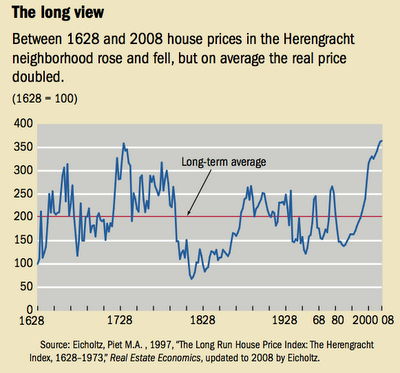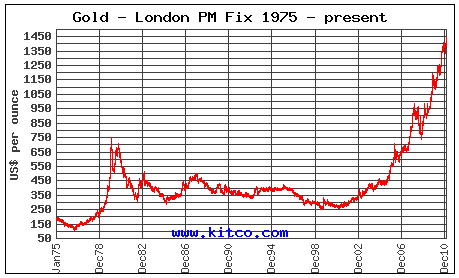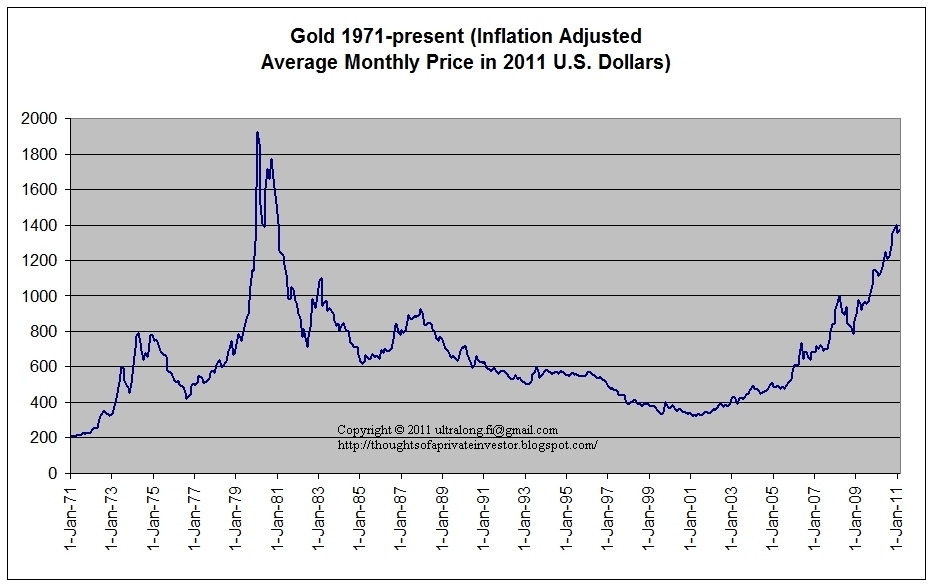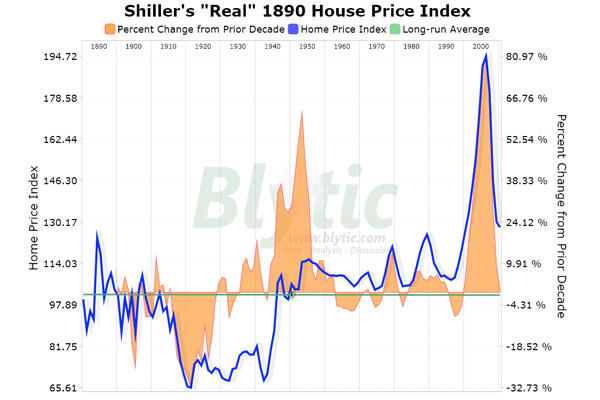 One thing I’ve always believed about investing (as opposed to speculating) is that it’s important to step back and take a look at the long-term picture.
One thing I’ve always believed about investing (as opposed to speculating) is that it’s important to step back and take a look at the long-term picture.In the shorter term, markets are subject to periodic “manias, panics and crashes”, as Charles Kindleberger put it in his classic study of financial crises. But in the long-term, prices tend to return to rational levels.
The recent housing boom and bust across much of the world was a classic example. Take the chart below (from Christian Science Monitor this week). You can see that from 1890 to the mid 1990s, US house prices basically went nowhere after adjusting for inflation. In other words, for more than a century, house prices delivered annual real returns of close to zero. That’s a surprisingly ordinary investment record.
But something changed from the mid 1990s. In a massive credit boom, the US had a decade of near double digit returns in the property market. If you were a young first home buyer with no knowledge of history, you could be forgiven at the time for believing mantras like “house prices double every seven years”, and “property is a better investment than shares because you can leverage it more.” (Hello Australia).
This Time is NOT Different
Of course, this was later proven to be a fantasy. As the chart above shows, the massive house price boom that was witnessed in the decade up to 2007 was a once in a century anomaly driven by Ponzi finance.
Today, after adjusting for inflation, US house prices have returned to roughly the same level they were in 1894. Almost one in four borrowers have negative equity in their homes. And the crash may not even be over. In fact, the chart above suggests that if US house prices are to return to their long-term trend (of simply growing in line with the rate of inflation), they have another 20% or so to fall.
Once again, this shouldn’t come as a great surprise if you take a look at the long-term history of house prices around the world. In fact, the longest study ever done of housing prices — a house price index for the Herengracht neighborhood of Amsterdam — shows that on average, real house prices only doubled over the 380 years or so since 1628. That’s an annual return of about 0.2%.

Last week, The Economist argued that Australian house prices were overvalued by 56% compared to long-term fundamentals. Now, we can quibble about the calculations behind this and the degree of overvaluation. But history shows that it is simply impossible for house prices to keep growing at a much faster rate than inflation and incomes.
As the famous fund manager Sir John Templeton once reportedly said, “this time is different” are the four most dangerous words an investor can say.
Gold Mania
All of this brings me to what is perhaps the greatest investing fad of the current era: gold.
The gold price has absolutely gone through the roof over the past year or so as fears have grown that easy money from the Fed and skyrocketing budget deficits are going to lead to rising inflation, or even hyperinflation.
After all, if you are convinced that the Fed is printing too much money and is going to “debase the dollar”, why would you hold dollar-denominated US Treasury bonds or paper currency? Gold, which has been synonymous with money for centuries, seems like a safe choice to preserve your wealth. If you switch on Fox News, you will see hundreds of TV commercials every day flogging gold ingots, coins and other hyperinflation remedies.

Now, my fellow Macrobusiness blogger The Prince reckons gold (and silver) could be on the verge of going “truly parabolic” over the next couple of years. I don’t disagree. With rising tensions in the Middle East, the possibility of Greece and some other peripheral European countries defaulting on their debt, and growing hysteria over the US budget deficit, there is plenty to worry about in the world.
But let’s step back for a moment and look at the big picture, as we did for house prices. We’ll start at 1971, which is when the link between the US dollar and gold was officially severed.
You can see below that apart from a huge speculative boom in the late 1970s (which ended with a massive crash), the price of gold in real terms has been relatively steady for much of the past four decades. This shouldn’t be too much of a surprise, because at the end of the day, there is nothing special about gold. Over the very long term, its price appreciation should basically be in line with the rise in the marginal cost of gold production, or the cost of extraction. And this cost tends to rise in line with the rate of broader inflation.

In the short term though, it’s a different story, and gold is special. Gold is the classic safehaven asset, and it can rise explosively in response to financial instability, war, or other sources of tension in the global economy. But the point is, there is a long-term anchor for gold prices: over hundreds of years, this has proven to be the rate of inflation minus the cost of storage. Which, by the way, is far below the long-term returns on stocks, bonds or property (which at least pays you a yield).
For a decade now, gold prices have far outpaced inflation. In fact, over the past five years, gold has delivered an annualized return of around 23%.
What does this mean? It means that if the inflationary doomsday scenario that is being priced in does not materialize, at some point gold is going to head south, big time.
As Warren Buffet said last week:
So there’s two types of assets to buy. One is where the asset itself delivers a return to you, such as, you know, rental properties, stocks, a farm. And then there’s assets that you buy where you hope somebody else pays you more later on, but the asset itself doesn’t produce anything. And those are two different games. I regard the second game as speculation.
Now there’s nothing immoral or illegal or fattening about speculation, but it is an entirely different game to buy a lump of something and hope that somebody else pays you more for that lump two years from now than it is to buy something you expect to produce income for you over time…
With an asset like gold, for example, you know, basically gold is a way of going along on fear, and it’s been a pretty good way of going along on fear from time to time. But you really have to hope people become more afraid in the year or two years than they are now.
And if they become more afraid you make money, if they become less afraid you lose money. But the gold itself doesn’t produce anything…
Buffet, of course, is absolutely right. When the fear subsides — which it inevitably will — the price of gold will plummet. And you will be left with a lump of metal that has no intrinsic value, is worth far less than what you bought it for, that pays you a yield of zero.
Gold is a useful inflation hedge, and I’m not claiming it shouldn’t have a small role to play in some people’s investment portfolios. If you really think the end of the world is nigh, go ahead and stock up on ingots. The rally in gold prices may still have a fair way to run.
But let’s not forget that gold is a highly volative, speculative investment that has quite possibly already appreciated well beyond its “fundamental” value.
Just as we’ve seen in the housing markets of the US, Spain and Ireland, no matter what asset we’re talking about, this time is NEVER different.
